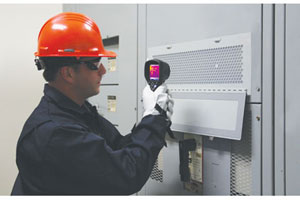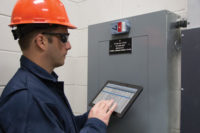
|
|
With IR windows, inspectors are never exposed to the dangers of arc flash. Photo courtesy of IRSS Group |
Value of NFPA
At the heart of NFPA 70E and OSHA initiatives is the hierarchy of control (HRC). This concept attempts to mitigate arc flash risk wherever possible. In order of preference, the HRC prioritizes:
1. Risk Elimination
2. Substitution (with lower risk)
3. Engineering Controls (such as arc-resistant switchgear)
4. Safe Work Practices
5. Personal Protective Equipment (PPE)
NFPA 70E and OSHA state that electrical equipment should be de-energized prior to opening. Some maintenance tasks have to be completed while the switchgear is loaded and energized, rapidly causing electrical maintenance safety devices (EMSDs) to be a hot topic. Their popularity is growing as companies strive to improve profitability, uptime and safety. Those who are implementing EMSD-based programs reap benefits in terms of efficiency gains, cost control and fire prevention. Because lower PPE levels are required, inspections are quicker.
EMSDs in action
One task that needs to be completed on electrical equipment while it is energized and under load is infrared (IR) scanning. IR cameras can only measure what they can see and cannot see through glass or plastic viewing windows commonly fitted in switchgear. To allow the inspections to be completed under load, an IR window can be used. This EMSD allows an IR camera to see the energized loaded connections through a special lens material in the IR windows. Switchgear can remain closed and in a safe and guarded condition thus ensuring that the inspector is never exposed to the dangers of arc flash or electrocution.
Much of the recent acceptance of IR windows has coincided with the increase in level of awareness regarding electrical safety, risk reduction and arc flash. Organizations such as the IEEE have been at the vanguard of this movement with its “Safer by Design” campaign. In response, switchgear manufacturers are increasingly installing IR window at the point of manufacture.
Other tasks where EMSDs are used to eliminate a potential arc flash include:
- Airborne Ultrasound (EMSD - Ultrasound Ports)
- Voltage Detection (EMSD - External Voltage detection ports)
- Motor Current Analysis (EMSD – Voltage Tap Off Connections)
- Other EMSD strategies include the use of online monitoring systems that transmit data back directly to the client utilizing either wired or wireless sensor systems. These systems include:
- Temperature measurement (Contact and non-contact systems)
- Vibration Analysis (Rotating UPS and generator systems)
- Power Quality (Online and fixed data collection systems)
- Partial Discharge (Online and fixed data collection systems)
Benefits of EMSDs
ESMDs standardize the inspection routes as they become data collection points for the test equipment. They ensure all inspection parameters are fixed and all collected data is standardized, ensuring any trend analysis data is accurate. Other benefits:
- Maintain switchgear in an enclosed and guarded condition
- Remove risk of electrocution and possible triggers of an arc flash incident
- Removal of high-risk behaviors
- Conduct valuable, fully loaded online inspections
- Access inaccessible equipment
- Because there is no panel removal required:
• inspections require less manpower
• inspections require lower PPE levels
• inspections are faster and more efficient
• More inspections are completed due to ease of operation
Compliance plus safety
Most electrical maintenance and safety standards value the use of Condition Based Maintenance (CBM) inspections such as IR surveys, ultrasound inspections, vibration analysis, MCA and partial discharge testing as a critical part of an electrical preventative maintenance program (EPM). EMSDs, such as IR windows, now provide a way for companies to comply with recommendations for inspection processes, while complying with the mandate for arc flash avoidance. Most if not all of these organizations agree that electrical equipment should not be opened unless it is de-energized. EMSDs provide a way for companies to comply with recommendations for inspection and safety standards/guidelines while protecting personnel, equipment and profits.



